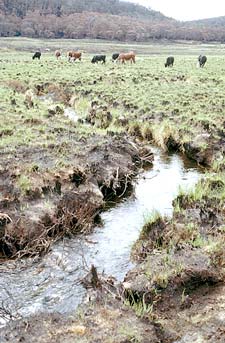|
1. Weed invasion.
The fire of January 2003 has left a lot of bare ground in the alps, and bare ground is vulnerable to weed invasion. It can take many years for this bare ground to recover, particularly at high altitudes where growth rates are very slow.
Cattle, because of their hard hooves, can stop the recovery of bare ground or even make the situation worse.
Cattle can also spread weeds (in their cowpats, or carried in their fur), particularly when they are trucked to a licence area.
 |
|
 |
Cattle readily move into fire-affected areas (PI)
|
|
Cow pat introducing weeds to the Caledonia area in the southern section the park this summer (5 years after the Caledonia fire) (PI)
|
Problem weeds, which outcompete native species, could greatly diminish biodiversity in the alps.
A new weed for the alps, Orange Hawkweed, is one of a number of invasive plants currently spreading through the Falls Creek Alpine Village. It has great potential to invade alpine grasslands, and is a rapid coloniser of bare ground (each plant can produce thousands of seeds asexually). It might also become a threat to agricultural land in southern lowland areas of Victoria.
Parks Victoria, DSE, and the Falls Creek Alpine Resort must co-operate in a rapid response plan to stop the spread of this plant before it is too late to control it.
The absence of cattle from the Bogong High Plains is one simple but important step to take in the fight against Orange Hawkweed.
 |
|
 |
|
 |
Orange Hawkweed at Falls Creek
|
|
Fire-affected ground trampled by cattle within site of Falls Creek Alpine Resort (Jan 2003) (PI)
|
|
Bare ground can take years to recover at high altitudes (JB)
|
2. Destruction of peat beds
Cattle have payed a major role, over the last 150 years, in the destruction of the many ancient peat beds (or sphagnum bogs) throughout the alps. These peat beds play a major role in the quality of alpine water systems, and in protecting alpine soils from erosion.
The only bogs that remain relatively intact are those bogs protected from cattle, usually by a cover of shrubs. Many of these bogs, sometimes called wet heaths, have lost their shrub cover after the fires, and it will take many years for them to regain that protection.
Note that peat bogs are listed as a 'threatened community' under Victoria's Flora and Fauna Guarantee Act
 |
|
 |
Wet Heath below Mount Mackay, before fires of Jan 2003 (shrub layer protects peat bed) (PI)
|
|
Wet Heath below Mount Mackay, after fires of Jan 2003 (protective shrub layer gone). This peat bog is now highly vulnerable to any cattle grazing in the vicinity of Pretty Valley (PI)
|
How cattle can destroy a peat bog following fire
|

|
Cattle in recovering landscape after the Caledonia fire (HW)
Click to enlarge
|
3. There are now very few parts of Victoria's High Country that have not suffered fire in the last 6 years. The Caledonia area in the south of the park was quite severely burnt in 1997/8, and most of the rest of the park was engulfed by the great drought-affected fire of January 2003. This has left very few intact areas to serve as colonising regions for the rest of the alps. While many plants have good fire survival strategies, some alpine plants don't, and some invertebrates and reptiles can benefit greatly if colonisation from unburnt areas is possible.
It could therefore be quite detrimental to the recovery of natural systems in the alps to allow grazing in those very few unburnt areas which are adjacent to, or surrounded by, burnt areas.
Note that the number of cattle involved in these unburnt zones adjacent to burnt areas is quite small (perhaps a few hundred head), but the effect they might have on recovery of some alpine species could be quite considerable.
4. Cattle have no capacity to stay within licence boundaries. They can't read signs; they can't understand instructions; they have no knowledge of conservation issues.
Generally, cattle roam many kilometres from the area covered by their licence. (Cattle are left unattended in the alps for most of the summer)
After fire, they are particularly attracted to the fresh 'green pick' of young growth, and will very readily move from unburnt to burnt areas for this reason.
5. Cattle, which cause erosion even in the most intact landscapes, can cause severe erosion and siltation of waterways after fire.
|